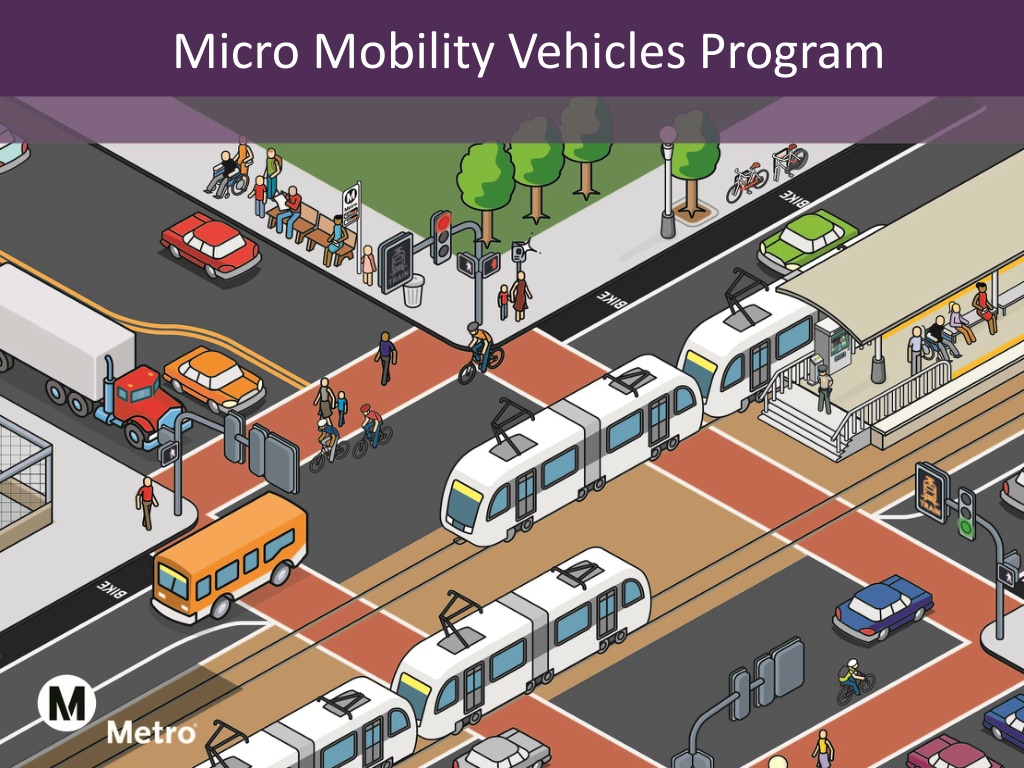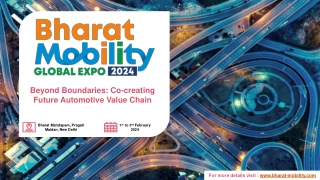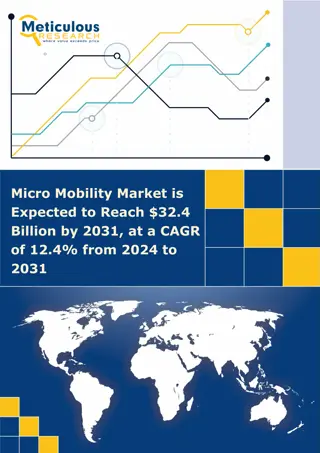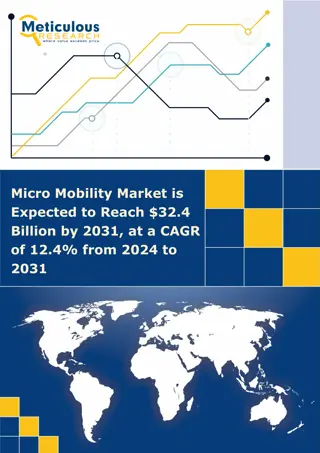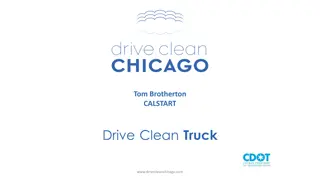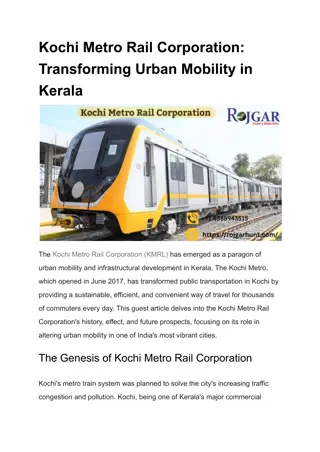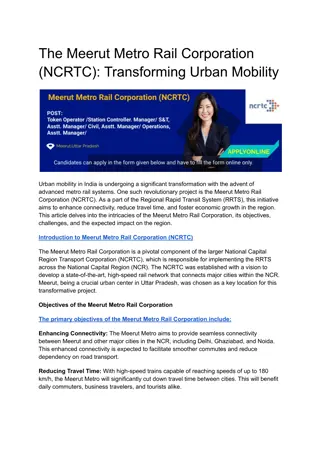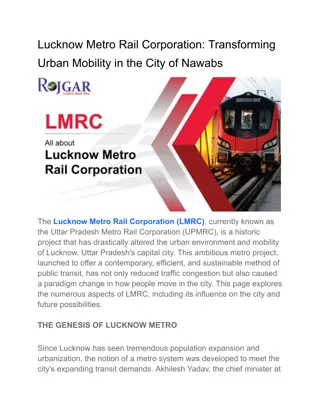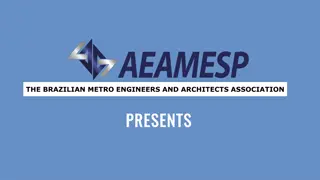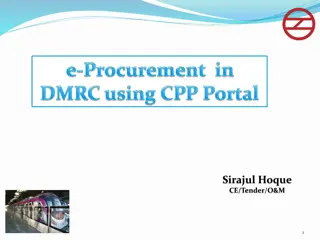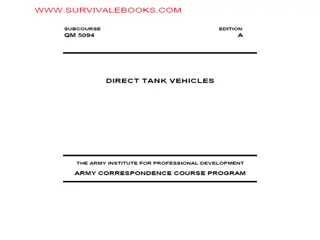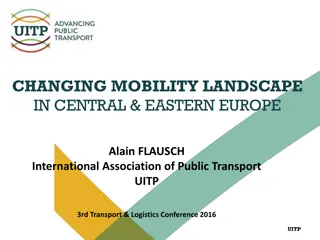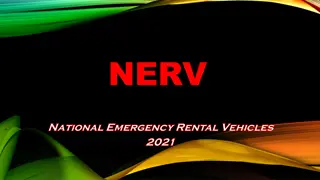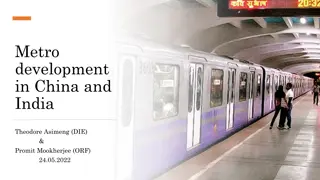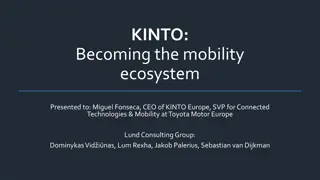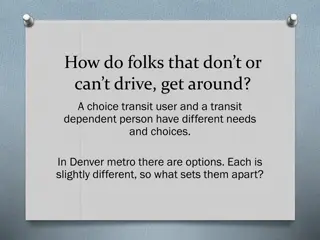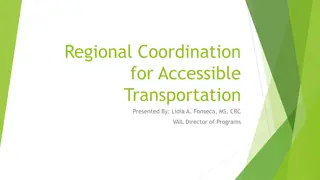Proposed Micro Mobility Vehicles Program for Metro Transportation
Micro mobility is transforming transportation, offering a new lifestyle with growing demand. This program aims to address safety, parking etiquette, and equity issues by either prohibiting or regulating micro mobility vehicles on Metro property. The proposed program includes designated parking spaces, license agreements, and enforcement measures for operating companies and users, ensuring compliance with regulations and prompt correction of violations.
Download Presentation

Please find below an Image/Link to download the presentation.
The content on the website is provided AS IS for your information and personal use only. It may not be sold, licensed, or shared on other websites without obtaining consent from the author. Download presentation by click this link. If you encounter any issues during the download, it is possible that the publisher has removed the file from their server.
E N D
Presentation Transcript
MICRO MOBILITY VEHICLES Micro mobility is evolving in the transportation industry. New transportation form = new lifestyle, with demand continuing to grow. Flexible and affordable mobility solution option Viable First/Last Mile connection for transit patrons Need to develop a program to prohibit or regulate them 2
PROGRAM Focus to address issues: Safety Appropriate parking etiquette Connect with Transit Equity 4
OPTIONS Prohibit micro mobility vehicles on Metro property, facilities, and ROW OR Regulate micro mobility vehicles through administrative program 5
PROPOSED PROGRAM Program concept: Modeled after Metro s Car Share program Designate spaces at Metro parking facilities Issue license agreement Enforcement: Parking Enforcement will perform enforcement activities: regulate behavior and record violation Administrative penalty will be applied to the operating company invoice for any violation 6
PROGRAM HIGHLIGHTS 1. Prohibited from parking in ADA spaces and must maintain clearance of ADA access. 2. Vehicle cap cannot supersede local jurisdiction laws, rules, and regulations. 3. Proof of permission from cities prior to operator applying with Metro 4. License agreement prior to operator deployment. 5. Incorrectly parked vehicles shall be corrected within 2 hours. 7
PROGRAM HIGHLIGHTS Operating Company responsibilities: Educate users on Metro s Ordinance. Provide parking plan and infrastructure. Correct violations within 2 hours after notification. User responsibilities: Park at designated spaces. Obey regulations for Metro s property, facilities, and ROW. If the user violates the Administration Code while operating the vehicle and is observed by Metro Security, Police or Parking Enforcement, a citation will be issued directly to the user. 8
GOVERNANCE California Vehicle Code Section 21113 authorizes Transportation agency to adopt Parking Ordinance to regulate Metro right-of-way and parking facilities. E-scooters and dockless bicycles will be considered as Micro Mobility Vehicles ( Vehicles ). Metro Parking Ordinance Administration Code 8 Micro Mobility Vehicle Ordinance is proposed to be included with Metro Parking Ordinance Non- Automobile chapter. Vehicles parked incorrectly will be subject to enforcement and removal by a tow company. 9
ORDINANCE Operating companies must acquire license agreement prior to deployment. Riders must dismount prior to transit fare gates, the boarding platform, station areas, and riding in transit. Vehicles must be parked/returned to pre-designated parking zone(s). Vehicles are prohibited from parking in ADA parking spaces and access path. Vehicles parked at non-designated areas will not be considered lost and found articles. 10
LOCATION CATEGORIES Category Description Example Station # of Stations Category 1 Station with a feasible parking facility at the station. North Hollywood, Norwalk, Willow 61 Category 2 Station with a non-feasible parking facility, but has sufficient space near or around the station to accommodate scooter parking. Expo/Sepulveda, Westlake/MacArthur Park, Irwindale 24 Category 3 Station with no parking facility, but with sufficient space near or around the station to accommodate scooter parking. Palms, Westwood/Rancho Park 14 Category 4 Station with no parking facility and without sufficient space near or around the station to accommodate scooter parking. Hollywood/Vine, Expo/USC, 26th St/Bergamot 67 11
EXAMPLE: CATEGORY 1 North Hollywood 12
EXAMPLE: CATEGORY 2 Expo/Sepulveda
EXAMPLE: CATEGORY 3 Palms 14
EXAMPLE: CATEGORY 4 Farmdale 15
PROPOSED FEES & ESTIMATED REVENUE Category Proposed Application Fee Proposed Fee Proposed Violation Fee $1500 per license agreement $125 per space per month Category 1 $1500 per license agreement $175 per space per month Category 2 $100 per occurrence $1500 per license agreement $250 per space per month Category 3 Flat Rate Option: $12,500 per month for all feasible stations (99+ Union Station) Estimated Revenue $553,000 License Agreement + $10,500 Application + Violation Fee Gross Revenue Estimate = $600,000 annually - $150,000 Enforcement Cost Net Revenue Estimate = $450,000 16
EQUITY PLATFORM 70.6% of all feasible stations considered are in a disadvantaged community ( DAC ) as defined by the California Environmental Protection Agency s CalEnviroScreen program. Operators are required to comply with each municipality s equity requirements to operate. LADOT requires a non-smartphone, cash, and low- income plan options Long Beach requires 40% of each fleet be stationed in DAC. Santa Monica requires Operators to establish and promote low-income qualified rates. 17
OTHER FINDINGS Conducted outreach with community-based advocacy groups. Main concern are the obstacles users may encounter. Support designated space for Vehicles. E-scooter use has demonstrated consistent use but it s not clear if e-scooters are removing automobiles from the road or replacing walking trips or transit use. Santa Monica reports the trend is more pronounced for bus than rail. Denver (RTD) reports 44% of users did not use scooters to connect to transit. Transit dependent users may prefer Metro transit due to low cost and free transfer. E-scooter fees may add an additional layer of cost. 18
OUTREACH & NEXT STEPS Three workshops One workshop with municipalities Invited all 88 cities; 57 representatives from 30 municipalities Two workshops with operators Seven operators attended both workshops Meetings 11 meetings with operators Internal department meetings Outreach to community-based advocacy groups Next Steps Continue outreach effort and obtain input Return to the Board for adoption in July 2019 19
QUESTIONS? Frank Ching LA Metro Deputy Executive Officer, Operational Programs Countywide Planning & Development 213.922.3033 W chingf@metro.net Jonathan Hofert, PE, TE, PTOE, ENV SP LA Metro Director, Engineering Program Management 213.418.3229 W hofertj@metro.net 20
